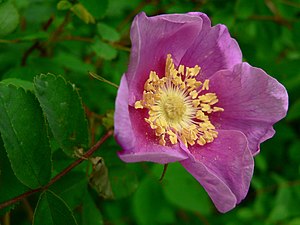Note: This is a project under development. The articles on this wiki are just being initiated and broadly incomplete. You can Help creating new pages.
Rosa nutkana - Wild rose
Rosa nutkana, the Nootka rose,[1] bristly rose, or wild rose is a 2–10 feet (0.61–3.05 m) tall perennial shrub in the rose family (Rosaceae).[2]
The species name nootka comes from the Nootka Sound of Vancouver Island, where the plant was first described. This plant is native to Western North America. There are 2 varieties: hispida grows in the Intermountain West, from east of the Cascades to the Rocky Mountains, and nutkana grows in coastal areas from Alaska to California, east to the Cascades. The Jepson Interchange (Flora of California) considers other varieties to be part of the nutkana variety.
Contents
Description
Rosa nutkana grows to as much as 3 meters, often in thickets. It has light green paired leaflets with toothed edges and sharp prickles at the base. The prickles are straight and paired and generally appear at nodes. The 2-3 inch pink (5–8 cm) flowers usually occur singly, but may appear in groups of 2 or 3. The flowers, which appear in early summer, can have a pleasantly strong fragrance. The sepals are very long, longer than the petals, and are constricted in the middle. The fruits (hips) of Nootka rose are somewhat bitter but edible. It is reported that bletting will greatly mitigate the bitterness and make the hips much more palatable. Only the rind should be eaten as the seeds are irritating.
Uses
- Rosa nutkana was used medicinally by a great number of indigenous peoples to treat a wide variety of ailments, and also ceremonially, in handcrafts, and as a food source.
- Nootka rose can be propagated from seed, although germination is spotty. Hardwood cuttings and root suckers can also be used.
- A decoction of the roots has been used by women after giving birth and also in the treatment of sore throats.[3]
